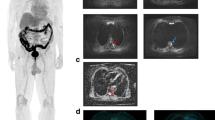Abstract
Objectives
To compare the diagnostic performance of whole-body magnetic resonance imaging (WBMRI) versus 18F-fluorodeoxyglucose (18F-FDG) positron emission tomography/computed tomography (PET/CT) for determination of remission status in patients with multiple myeloma (MM) after stem cell transplantation (SCT).
Methods
Thirty-one patients were examined by both WBMRI and PET/CT after SCT. Imaging results and clinical remission status as determined by the clinical gold standard (Uniform Response Criteria) were compared.
Results
One hundred four lesions were detected in 21 patients. PET/CT had a sensitivity of 50.0 %, a specificity of 85.7 %, a positive predictive value of 62.5 %, a negative predictive value of 78.3 %, and an overall accuracy of 74.2 % for determination of remission status. MRI had a sensitivity of 80.0 %, a specificity of 38.1 %, a positive predictive value of 38.1 %, a negative predictive value of 80 %, and an overall accuracy of 51.6 %. Concordant results were observed in only 12 (11.5 %) of the 104 lesions.
Conclusions
In the post-treatment setting, both FDG PET/CT and WBMRI provide information about the extent of disease, allowing for a more comprehensive evaluation of persisting or recurrent myeloma. MRI may often be false positive because of persistent non-viable lesions. Therefore, PET/CT might be more suitable than MRI for determination of remission status.
Key Points
• Both whole-body MRI and 18 F-FDG PET/CT are now used for assessing multiple myeloma
• Both investigations may visualise residual or recurrent disease after stem cell transplantation
• MRI may give false-positive results because of persistent inactive lesions



Similar content being viewed by others
References
Bataille R, Harousseau JL (1997) Multiple myeloma. N Engl J Med 336:1657–1664
Sirohi B, Powles R (2004) Multiple myeloma. Lancet 363:875–887
Kroger N (2007) Mini-midi-maxi? How to harness the graft-versus-myeloma effect and target molecular remission after allogeneic stem cell transplantation. Leukemia 21:1851–1858
Zamagni E, Patriarca F, Nanni C et al (2011) Prognostic relevance of 18-F FDG PET/CT in newly diagnosed multiple myeloma patients treated with up-front autologous transplantation. Blood 118:5989–5995
Durie BG, Harousseau JL, Miguel JS et al (2006) International uniform response criteria for multiple myeloma. Leukemia 20:1467–1473
Derlin T, Weber C, Habermann CR et al (2012) 18F-FDG PET/CT for detection and localization of residual or recurrent disease in patients with multiple myeloma after stem cell transplantation. Eur J Nucl Med Mol Imaging 39:493–500
Lin C, Luciani A, Belhadj K et al (2010) Multiple myeloma treatment response assessment with whole-body dynamic contrast-enhanced MR imaging. Radiology 254:521–531
Blade J, Samson D, Reece D et al (1998) Criteria for evaluating disease response and progression in patients with multiple myeloma treated by high-dose therapy and haemopoietic stem cell transplantation. Myeloma Subcommittee of the EBMT. European Group for Blood and Marrow Transplant. Br J Haematol 102:1115–1123
Durie BG, Waxman AD, D’Agnolo A, Williams CM (2002) Whole-body (18)F-FDG PET identifies high-risk myeloma. J Nucl Med 43:1457–1463
Bartel TB, Haessler J, Brown TL et al (2009) F18-fluorodeoxyglucose positron emission tomography in the context of other imaging techniques and prognostic factors in multiple myeloma. Blood 11:2068–2076
Nanni C, Zamagni E, Farsad M et al (2006) Role of 18F-FDG PET/CT in the assessment of bone involvement in newly diagnosed multiple myeloma: preliminary results. Eur J Nucl Med Mol Imaging 33:525–531
Durie BG (2006) The role of anatomic and functional staging in myeloma: description of Durie/Salmon plus staging system. Eur J Cancer 42:1539–1543
Becherer A, De Santis M, Karanikas G et al (2005) FDG PET is superior to CT in the prediction of viable tumour in post-chemotherapy seminoma residuals. Eur J Radiol 54:284–288
Kobe C, Dietlein M, Franklin J et al (2008) Positron emission tomography has a high negative predictive value for progression or early relapse for patients with residual disease after first-line chemotherapy in advanced-stage Hodgkin lymphoma. Blood 112:3989–3994
Baur-Melnyk A, Buhmann S, Durr HR, Reiser M (2005) Role of MRI for the diagnosis and prognosis of multiple myeloma. Eur J Radiol 55:56–63
Fonti R, Salvatore B, Quarantelli M et al (2008) 18F-FDG PET/CT, 99mTc-MIBI, and MRI in evaluation of patients with multiple myeloma. J Nucl Med 49:195–200
Zamagni E, Nanni C, Patriarca F et al (2007) A prospective comparison of 18F-fluorodeoxyglucose positron emission tomography-computed tomography, magnetic resonance imaging and whole-body planar radiographs in the assessment of bone disease in newly diagnosed multiple myeloma. Haematologica 92:50–55
Bauerle T, Hillengass J, Fechtner K et al (2009) Multiple myeloma and monoclonal gammopathy of undetermined significance: importance of whole-body versus spinal MR imaging. Radiology 252:477–485
Landis JR, Koch GG (1977) The measurement of observer agreement for categorical data. Biometrics 33:159–174
Dimopoulos M, Terpos E, Comenzo RL et al (2009) International myeloma working group consensus statement and guidelines regarding the current role of imaging techniques in the diagnosis and monitoring of multiple myeloma. Leukemia 23:1545–1556
Kwee TC, Basu S, Saboury B, Ambrosini V, Torigian DA, Alavi A (2011) A new dimension of FDG-PET interpretation: assessment of tumor biology. Eur J Nucl Med Mol Imaging 38:1158–1170
Shortt CP, Gleeson TG, Breen KA et al (2009) Whole-Body MRI versus PET in assessment of multiple myeloma disease activity. AJR Am J Roentgenol 192:980–986
Paiva B, Vidriales MB, Cervero J et al (2008) Multiparameter flow cytometric remission is the most relevant prognostic factor for multiple myeloma patients who undergo autologous stem cell transplantation. Blood 112:4017–4023
Horger M, Weisel K, Horger W, Mroue A, Fenchel M, Lichy M (2011) Whole-body diffusion-weighted MRI with apparent diffusion coefficient mapping for early response monitoring in multiple myeloma: preliminary results. AJR Am J Roentgenol 196:W790–W795
Author information
Authors and Affiliations
Corresponding author
Rights and permissions
About this article
Cite this article
Derlin, T., Peldschus, K., Münster, S. et al. Comparative diagnostic performance of 18F-FDG PET/CT versus whole-body MRI for determination of remission status in multiple myeloma after stem cell transplantation. Eur Radiol 23, 570–578 (2013). https://doi.org/10.1007/s00330-012-2600-5
Received:
Revised:
Accepted:
Published:
Issue Date:
DOI: https://doi.org/10.1007/s00330-012-2600-5




